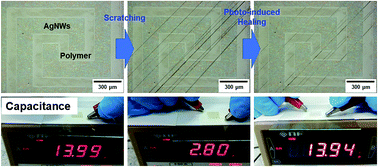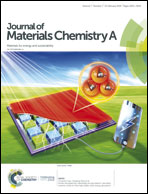Transparent, pressure-sensitive, and healable e-skin from a UV-cured polymer comprising dynamic urea bonds†
Abstract
Most intrinsically healable polymers feature a soft nature and high flowability that arise from the reversible formation of bonds (e.g., cross-linkages). Unfortunately, a trade-off relationship between mechanical strength and healing capability is observed for the majority of these polymers, which necessitates the search for better alternatives. Herein, we synthesized a urethane acrylate-based intrinsically healable material with enhanced mechanical properties, demonstrating that this enhancement originates from the presence of UV curing-produced dynamic urea bonds acting as reversible cross-linkages. The synthesized polymer was hybridized with silver nanowires (AgNWs) to afford a transparent pressure-sensitive e-skin capable of irradiation-induced healing, i.e., the heating of AgNWs by a series of intense pulsed light (IPL) irradiations allowed one to instantly and rapidly repair the cutting marks or scratches artificially formed on e-skin sensors. The healing ability was originated from the enhanced flowability and thermal expansion of the polymer during IPL irradiation. Consecutive cutting-healing cycling showed that the cutting marks formed at the same locations could be effectively repaired for up to five times. The fringing effect-associated capacitance of a AgNW tandem compound pattern significantly increased with increasing pressure applied to the sensor surface, and the electric function of damaged sensors was successfully restored by irradiation-induced healing.



 Please wait while we load your content...
Please wait while we load your content...